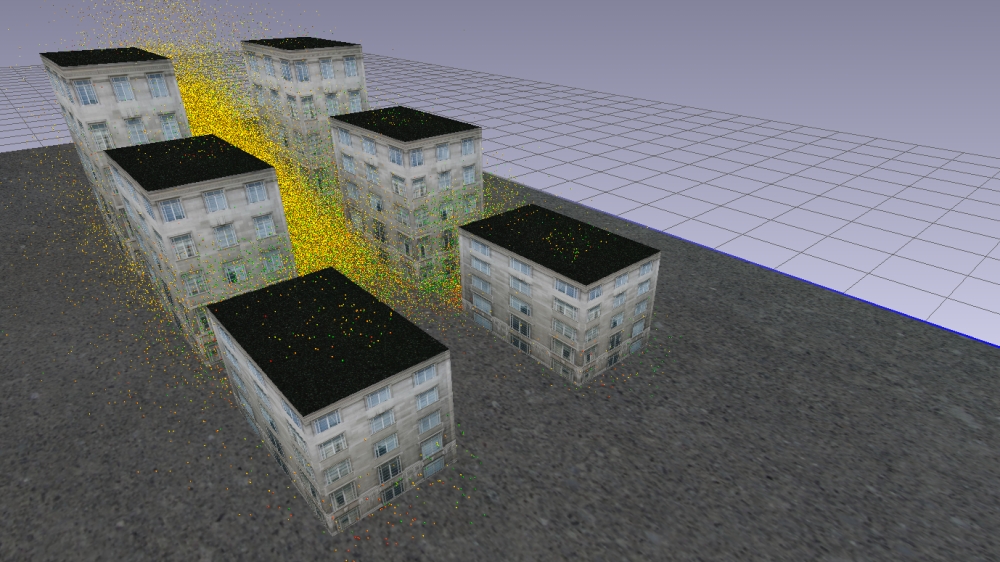|
Treadport Adaptive Wind Tunnel |
The Treadport Adaptive Wind Tunnel (TPAWT) is designed to add tactile wind sensation to the University of Utah Treadport virtual environment. The goal is to generate wind from any direction with specified velocity. A particular challenge is to create a wind generation system within the existing confines of the Treadport. The most salient feature is the CAVE-like frontal visual display, consisting of three screens filling 180 degrees of view, which cannot be interfered with.
TPAWT Design Concept
In order to produce realistic flow fields within the confines of the existing Treadport geometry, the TPAWT design employs passive re-direction and mixing to achieve desired flow fields. To produce a desired flow field, jets of air are injected into the periphery of the Treadport and using existing components, such as the virtual environment display screens, the jets are re-directed towards common points and mixed. Additional sidewalls, roof, and floor panels are included in the conceptual design to aid in control of the air injected. The conceptual design uses four circular jets located horizontally in the floor and roof panels of the TPAWT near the Treadport user location.

|

|
The design of the jets allow for both horizontal and vertical control of air direction. Counterrotating vortices are formed and manipulated by velocity and direction control of the air from the vents. Several concepts for the jet-style air delivery system have been proposed and the conceptual designs are being evaluated for air delivery performance and necessary range of motion. From this conceptual design numerical models have been built and analyzed using computational fluid dynamics for air delivery performance.
Scale Model Testbed and Controller
In addition to simulation studies, a quarter scaled model of the TPAWT has been created for experimenting with structures and for developing control algorithms. In order to approximate 2D flow, the aspect ratio was set to 1:9 by making the gap height between floor and ceiling equivalent to diameter of vents, throughout the test section.
To control airflow in real-time, a combination of passive and active controllers is implemented. The passive control is achieved by the guidance of wind flow from the vents along the side screens of the TPAWT. In the steady flow case, the flow from the vents merge at the front screen, separate and then deflect towards the user. The output feedback control of wind angle is implemented by varying the vent velocity ratios between the left and right vent. The sum of the speeds measured from the left and right vent is used as a control input for achieving desired wind speed at the user.

|

|
For the unsteady flow case, a negative pressure plenum at the rear part of the Treadport is added for reducing oscillation of the core flow. A conditional angular rate-switching feedback controller is developed to create a headwind at the user. This controller maintains the headwind at the user within 1-3 degrees. A vorticity-meter placed above the user position verifies that the core flow is centered at the user. Along with this, a predetermined active control in the form of a slit in the floor of the front screen of TPAWT is added. This improves steadiness in the dynamics of the flow for the directional wind control. A combined speed and angle control over a range of wind angles of +/-30 degrees for the scale model testbed is thus achieved. Future research involves improving the performance and accuracy.
Full-Scale TPAWT
Real-time Modeling of Wind Flow in Urban Environments
Modeling and simulating the wind within a real-time interactive virtual environment has potential for increasing immersion on several levels. From a visual perspective, accessing simulated wind field data can assist in creating a richer dynamic visual experience with leaves blowing through the environment, trees reacting to the wind, or autonomous pedestrians leaning into strong wind gusts. Such visual elements work to create a more dynamic, ambient environment consistent with real environments. With regard to physical interaction, users can feel the wind within the environment on their bodies and relate the visual aspects of the wind's effect (leaves, flags, etc...) to their own actions within the virtual environment. Perhaps the best illustration of this combined visual and physical interaction comes from an urban environment simulation in which the user feels the wind produced in the wake of a bus driving by them as the user stands on a virtual curb.

|

|
To obtain this system, we are applying Graphics Processing Units (GPUs) to the simulation of wind and particle dispersion modeling in urban areas. We have implemented a Lagrangian particle dispersion model based on the Quick Urban and Industrial Complex (QUIC) Dispersion Modeling System on the GPU. With our system, the GPU simulations outperformed the CPU simulations by over an order of magnitude in an urbanized domain with buildings. Our primary challenge has been in exploring visualization and interaction methods that assist the computational fluid dynamics engineers that work on the project. In particular, these engineers have found that real-time visualization and interaction with their flow models (something they have not been able to do until now) has been extremely beneficial for debugging and understanding turbulence models. Our efforts have focused on finding better means to visualize and interact with the components of the flow model.